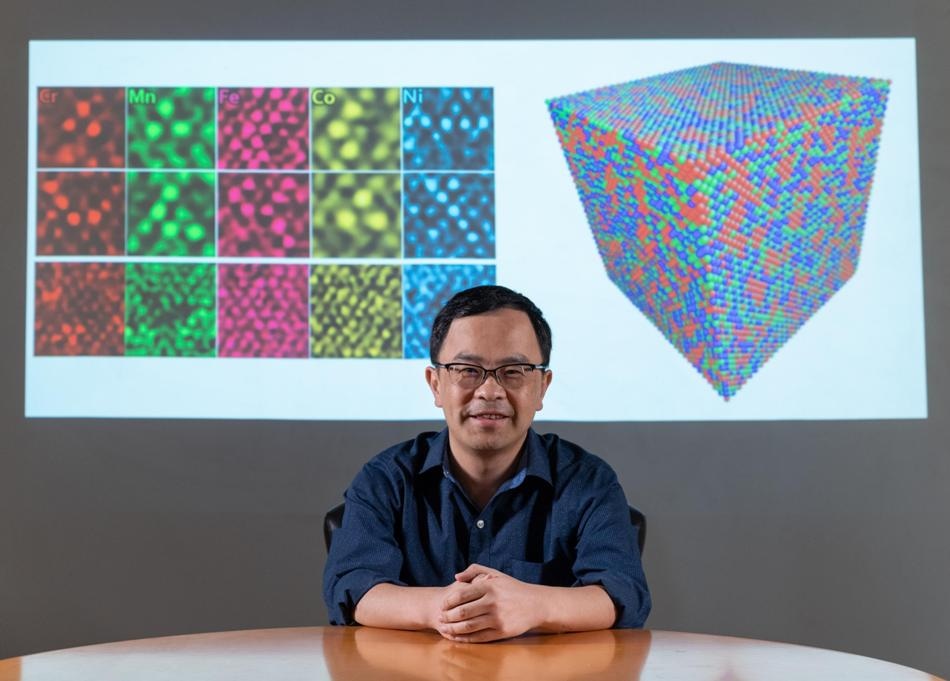Oct 11 2019
High-entropy alloys, produced from almost equal parts of a number of primary metals, might exhibit immense potential for developing materials with excellent mechanical properties.
 Ting Zhu, a professor in the George W. Woodruff School of Mechanical Engineering at Georgia Tech, has helped develop a new process to gain insights into individual high-entropy alloys and help characterize their properties. (Image credit: Rob Felt)
Ting Zhu, a professor in the George W. Woodruff School of Mechanical Engineering at Georgia Tech, has helped develop a new process to gain insights into individual high-entropy alloys and help characterize their properties. (Image credit: Rob Felt)
However, with a virtually unlimited number of potential combinations, one challenge faced by metallurgists lies in identifying where to direct their research efforts in an expansive, uninvestigated realm of metallic mixtures.
A new process capable of guiding such efforts has been developed by a research team from the Georgia Institute of Technology. In their method, an atomic-resolution chemical map is developed to help better understand individual high-entropy alloys and characterize their properties.
On October 9th, 2019, the researchers’ study was reported in the journal Nature. In this study, the researchers have explained the use of energy-dispersive X-ray spectroscopy to produce maps of individual metals in two high-entropy alloys.
When used together with transmission electron microscopy, this spectroscopy method helps detect X-rays released by a sample when it is bombarded by an electron beam, to describe the elemental composition of the analyzed sample.
The maps demonstrate how individual atoms organize themselves inside the alloy, enabling researchers to search for patterns that could help in designing alloys highlighting individual properties.
For instance, the maps could offer scientists clues to comprehend why replacing one metal for another could make an alloy weaker or stronger, or why one metal outshines others in very cold environments.
Most alloys used in engineering applications have only one primary metal, such as iron in steel or nickel in nickel-based super alloys, with relatively small amounts of other metals. These new alloys that have relatively high concentrations of five or more metals open up the possibility of unconventional alloys that may have unprecedented properties.
Ting Zhu, Professor, George W. Woodruff School of Mechanical Engineering, Georgia Tech
Zhu continued, “But this is a new compositional space that has not been explored, and we still have a very limited understanding of this class of materials.”
The term “high entropy” denotes the lack of uniformity in the combination of metals and also specifies how many different and slightly random ways in which the atoms from the metals can be organized as they are combined.
With the new maps, it could also be possible for researchers to decide whether such alloys take any unusual atomic structures that could be exploited for engineering applications, as well as the level of control researchers could have over the combinations to “tune” them for particular traits, stated Zhu.
The researchers tested the new imaging approach by comparing two high-entropy alloys composed of five metals. One was a blend of iron, chromium, nickel, cobalt, and manganese, a combination often termed as a “Cantor” alloy. The other one was similar but replaced palladium for the manganese. This one substitution led to considerably different behavior in how the atoms positioned themselves in the mixture.
In the Cantor alloy, the distribution of all five elements is consistently random. But with the new alloy containing palladium, the elements show significant aggregations due to the much different atomic size of palladium atoms as well as their difference in electronegativity compared to the other elements.
Ting Zhu, Professor, George W. Woodruff School of Mechanical Engineering, Georgia Tech
The mapping in the new alloy with palladium indicated that palladium shows a tendency to form huge clusters, while cobalt appeared to accumulate in places where iron was in lesser concentrations.
Those combinations, along with their spacings and sizes in the range of a few nanometers, offer robust resistance to deformation and could account for the variations in mechanical properties from one high-entropy alloy to another.
In straining tests, the alloy with palladium displayed greater yield strength while maintaining similar tensile ductility and strain hardening as the Cantor alloy.
“The atomic scale modulation of element distribution produces the fluctuation of lattice resistance, which strongly tunes dislocation behaviors,” stated Qian Yu, a co-author of the paper and a professor in Zhejiang University. “Such modulation occurs at a scale that is finer than precipitation hardening and is larger than that of traditional solid solution strengthening. And it provides understanding for the intrinsic character of high-entropy alloys.”
Going forward, the results could assist researchers in custom designing alloys, by exploiting one property or another.
We believe that this work is really important, as local chemical ordering in these extremely high profile, high-entropy alloys is critical to dictating their properties. Indeed, this presents a way to tailor these materials to attain optimal properties by atomic design.
Robert Ritchie, Study Co-Author and Professor, University of California, Berkeley
Researchers from the University of Tennessee, Knoxville; Tsinghua University; and the Chinese Academy of Sciences were also part of the team.
This study was supported by the National Science Foundation through grant No. DMR-1810720, the Department of Energy through contract No. DE-AC02-05CH11231, the National Natural Science Foundation of China through grant No. B16042, and the State Key Program for Basic Research in China under grant No. 2015CB659300.